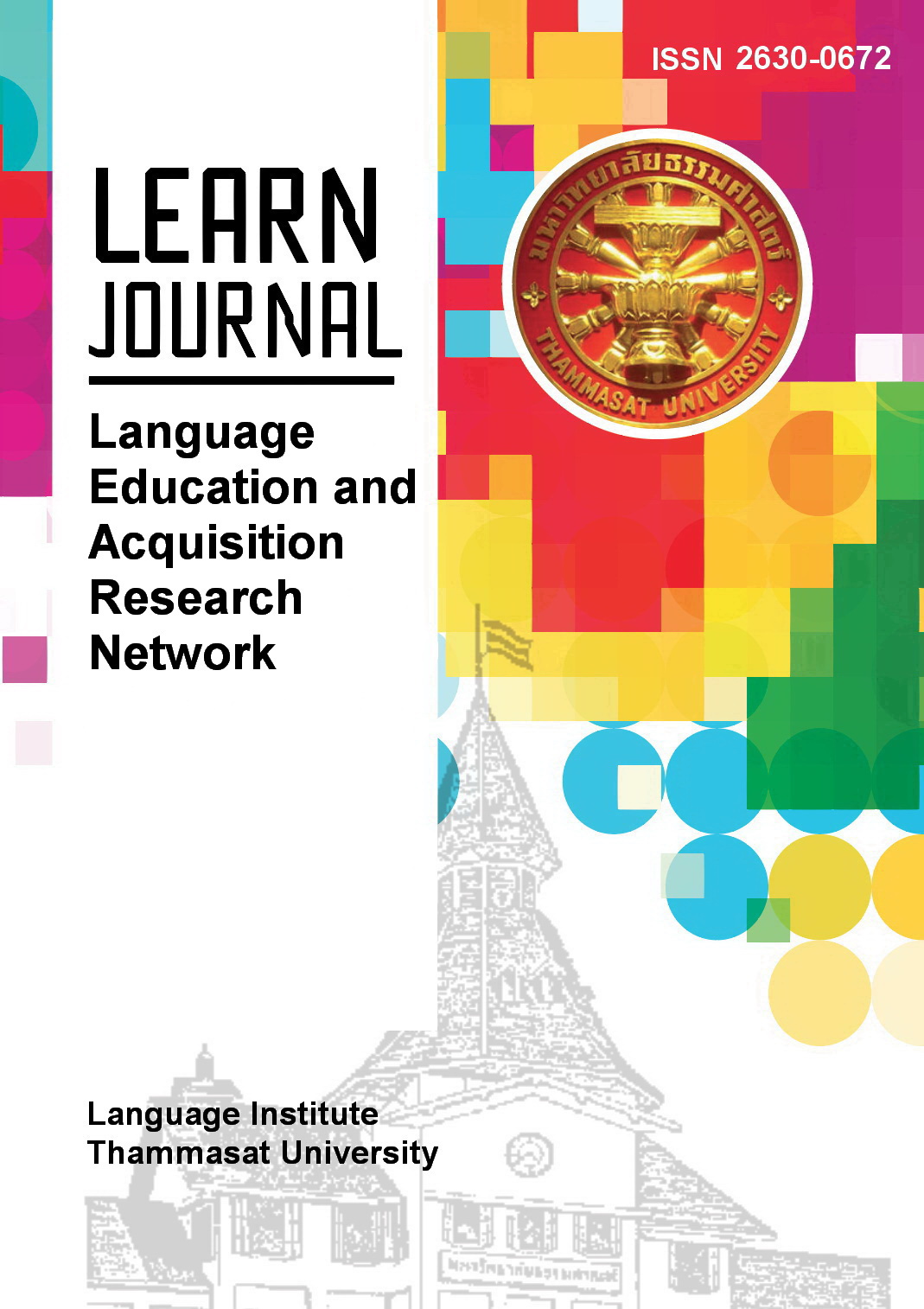Perceptions of In-Service Teachers Towards CLIL and CLIL Teachers’ Target Language and Intercultural Competences: The Context of English-Medium Instruction Schools in Thailand
Main Article Content
Abstract
This study is aimed at investigating the perceptions of in-service English-medium instruction (EMI) teachers towards CLIL and CLIL teachers’ target language and intercultural competences. The participants were 59 Thai/local and international native English-speaking teachers (NESTs) and non-native English-speaking teachers (NNESTs) at EMI schools in Thailand. The participants attended the one-day CLIL teacher training workshop used as the research context of the study. Questionnaire and audio recordings of the workshop were used as instruments in collecting both quantitative and qualitative data. Results indicated that Thai teachers generally perceived their CLIL knowledge and competences as the lowest in all areas. International NNESTs, by contrast, ranked themselves the highest in most areas, except for overall target language competence, where their perceived competence was slightly lower than international NESTs. These results can raise question of whether NESTs are more competent in EMI classrooms. Through thematic analysis, it was found that opportunities to learn and share about CLIL, to use English in intercultural settings, and to learn about intercultural awareness can contribute to EMI/CLIL teacher competences. Recommendations are provided regarding CLIL teachers’ professional development for local and international teachers in the Thai EMI school contexts and alike.
Article Details
References
An, J., Macaro, E., & Childs, A. (2021.) Classroom interaction in EMI high schools: Do teachers who are native speakers of English make a difference? System, 98. https://doi.org/10.1016/j.system.2021.102482
Bax, D. S. (2010). Researching English bilingual education in Thailand, Indonesia and South Korea. British Council. http://www.teachingenglish.org.uk/sites/teacheng/files/publication_2_-_researching_english_bilingual_education.pdf
Bertaux, P., Coonan, C. M., Frigols-Martín, M. J., & Mehisto, P. (2010). The CLIL teacher’s competences grid. Common Constitution and Language Learning (CCLL) Comenius Network. http://ccll-eu.eu/cms02/fileadmin/daten/Dateien/Konferenzen/THE_CLIL_TEACHER_latest_version.pdf
Boonprasop, S., Chaichompoo, S., & Khonchalard, K. (2018). Factors affecting student achievements of English programs in secondary schools under the Office of Basic Education Commission Thailand. Journal of Education, 29(2),158-174.
Braun, V., & Clarke, V. (2006). Using thematic analysis in psychology. Qualitative Research in Psychology, 3(2), 77-101. https://doi.org/10.1191/1478088706qp063oa
British Council. (2006). Future perfect-English language policy for global transition conference report. British Council Thailand. http://my.britishcouncil.or.th/upload/futureperfect/statement-of-conference-outcomes.pdf
Byram, M., Gribkova, B., & Starkey, H. (2002). Developing the intercultural dimension in language teaching: A practical introduction for teachers. Council of Europe. https://rm.coe.int/16802fc1c3
Charttrakul, K., & Damnet, A. (2021). Role of the CEFR and English teaching in Thailand: A case study of Rajabhat Universities. Advances in Language and Literary Studies, 12(2), 82-89.
Cortina-Pérez, B., & Pino Rodríguez, A. N. (2021). Analysing CLIL teacher competences in pre-service preschool education. A case study at the University of Granada. European Journal of Teacher Education. https://doi.org/10.1080/02619768.2021.1890021
Coyle, D., Hood, P., & Marsh, D. (2010). CLIL: Content and language integrated learning. Cambridge University Press.
Cummins, J. (1979). Cognitive/academic language proficiency, linguistic interdependence, the optimum age question and some other matters. Working Papers on Bilingualism, 19, 121-129.
Dalton-Puffer, C. (2011). Content-and-language integrated learning: From practice to principles? Annual Review of Applied Linguistics, 31, 182–204. https://doi.org/10.1017/S0267190511000092
Halcomb, E. J., & Davidson, P. M. (2006). Is verbatim transcription of interview data always necessary? Applied Nursing Research, 19, 38 – 42. https://doi.org/10.1016/j.apnr.2005.06.001
Kewara, P., & Prabjandee, D. (2018). CLIL teacher professional development for content teachers in Thailand. Iranian Journal of Language Teaching Research, 6(1), 93-108.
Mahan, K. R. (2020) The comprehending teacher: Scaffolding in content and language integrated learning (CLIL). The Language Learning Journal. https://doi.org/10.1080/09571736.2019.1705879
Marsh, D., Mehisto, P., Wolff, D., & Frigols, M. J. (2010). European Framework for CLIL Teacher Education. ECML.
OECD. (2018). Teacher Questionnaire: TALIS 2018 Questionnaires. https://www.oecd.org/education/school/TALIS-2018-MS-Teacher-Questionnaire-ENG.pdf
Ørngreen, R., & Levinsen, K. (2017). Workshops as a research methodology. The Electronic Journal of eLearning, 15(1), 70-81.
Papaja, K.L. (2013). The role of a teacher in a CLIL classroom. Glottodidactica. An International Journal of Applied Linguistics, 40, 147-153. https://doi.org/10.14746/gl.2013.40.1.11
Pavón Vázquez, V., & Ellison, M. (2013). Examining teacher roles and competences in Content and Language Learning (CLIL). Linguarum Arena, 4, 65-78.
Pérez Cañado, M. L. (2016). Teacher training needs for bilingual education: In-service teacher perceptions. International Journal of Bilingual Education and Bilingualism, 19(3), 266-295. https://doi.org/10.1080/13670050.2014.980778
Pérez Cañado, M. L. (2018). Innovations and challenges in CLIL teacher training, Theory Into Practice, 57(3), 212-221. https://doi.org/10.1080/00405841.2018.1492238
Pham, P. A., & Unaldi, A. (2021). Cross-curricular collaboration in a CLIL bilingual context: The perceptions and practices of language teachers and content subject teachers. International Journal of Bilingual Education and Bilingualism. https://doi.org/10.1080/13670050.2021.1995320
Qiu, X., & Fang, C. (2019). Creating an effective English-Medium Instruction (EMI) classroom: Chinese undergraduate students’ perceptions of native and non-native English-speaking content teachers and their experiences, International Journal of Bilingual Education and Bilingualism. https://doi.org/10.1080/13670050.2019.1707769
Tachaiyaphum, N., & Sukying, A. (2017). EFL pre-service teachers’ perceptions of CLIL. Asian Education Studies, 2(4), 44-56. https://doi.org/10.20849/aes.v2i4.283
Tanielian, A.R. (2014). Foreign language anxiety in a new English program in Thailand. The International Education Journal: Comparative Perspectives, 13(1), 60-81.
Ulla, M. B. (2019). Filipinos as EFL teachers in Bangkok, Thailand: Implications for language education policy in the ASEAN region. RELC Journal. https://doi.org/10.1177/0033688219879775
Vilkancienė, L., & Rozgienė, I. (2017). CLIL teacher competences and attitudes. Sustainable Multilingualism,11(1), 196-218. https://doi.org/10.1515/sm-2017-0019


